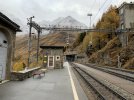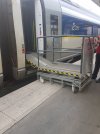kingqueen
Member
In Switzerland, under their Disability Discrimination Law (BeHiG) the SBB has committed to making all stations "barrier free" (step free access to the platforms and level boarding onto trains.
Despite admirable resource expenditure, it hasn't reached that yet. So they made a commitment.
But this doesn't seem to apply to other operators - even though assistance is still coordinated (and perhaps provided?) by SBB.
For instance, RhB. A station I would like to use next month: Alp Grüm, remote station, has step free access to platforms but no level access to the train - and RhB / SBB refuse to provide a ramp or lift onto/off the train.
(I guess an equivalent station in the UK would be Corrour, no road access but sorta level access platform and the guard puts down a ramp no problem. In the UK, train operators are obliged to provide assistance at all their stations, even if it is a taxi from an inaccessible one.)
What I'm wondering is, why it is OK for the RhB to not provide assistance at some otherwise accessible stations, whereas the SBB think it is mandatory under the BeHiG.
A bit esoteric, Swiss rail accessibility law, I know, but thought I'd just ask
Despite admirable resource expenditure, it hasn't reached that yet. So they made a commitment.
AndWe are therefore offering temporary alternative solutions at all stations that are not autonomously barrier-free from the beginning of 2024.
(Machine translation of a SBB blog post I'm now struggling to find, but the commitment is public and clear.)the law also allows alternative measures such as assistance from staff at train stations where the benefit of an adaptation is offset by disproportionately high costs. SBB is temporarily offering such assistance at all train stations that will not be autonomously barrier-free from the beginning of 2024.
But this doesn't seem to apply to other operators - even though assistance is still coordinated (and perhaps provided?) by SBB.
For instance, RhB. A station I would like to use next month: Alp Grüm, remote station, has step free access to platforms but no level access to the train - and RhB / SBB refuse to provide a ramp or lift onto/off the train.
(I guess an equivalent station in the UK would be Corrour, no road access but sorta level access platform and the guard puts down a ramp no problem. In the UK, train operators are obliged to provide assistance at all their stations, even if it is a taxi from an inaccessible one.)
What I'm wondering is, why it is OK for the RhB to not provide assistance at some otherwise accessible stations, whereas the SBB think it is mandatory under the BeHiG.
A bit esoteric, Swiss rail accessibility law, I know, but thought I'd just ask



